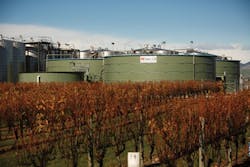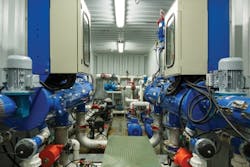About the author: Rex Gibbs is director for Factor UTB. Gibbs can be reached at [email protected].
Treasury Wine Estates Ltd. (TWE) planned to expand the capacity of its existing Matua Marlborough winery in New Zealand from 13,500 tons equivalent (te) to 24,000 te, with the capacity to expand it further to 35,000 te in the future. As a condition of approval for the expansion, Marlborough Regional Council required a significant reduction of the loads from winery waste to the environment. Past practice had been to irrigate the wastewater onto an extensive area of pasture, but that pasture area was showing degradation and eutrophication.
As a precondition to approval, TWE needed to demonstrate a significant reduction in environmental impact. The City Council was keen to see the expansion of a significant employer and leased an existing woodlot area 2 miles from the winery to provide a more extensive disposal area. The irrigated area is adjacent to the Wairau River, and so the discharge needed to be treated so that pollutant and nutrient loads were well within the capacity of the irrigated area to absorb without risking contamination of the river.
The site area available to build the plant was limited, with 130 by 115 ft accessible for treatment and sludge dewatering. Winery wastewater flows are highly seasonal, and it is necessary to deal with extra load capacity for vintage and peak processing. The nature of the waste stream varies widely both daily and seasonally. The waste from crush is different from the waste from filtering and blending of wine or cleaning barrels. It ranges from highly acidic to alkaline depending on the process stage. Aerated systems are superior to anaerobic systems in this application, as they tolerate and respond to the highly variable loads that most wineries produce.
One could say that dealing with waste from a winery of this size is like having 22,000 people turning up to party for a month on the first day of vintage, with half leaving at the end of vintage and the rest staying on for the next nine months. And as serious partygoers, many come back for a few days regularly, but without notice.
The plant has already survived two earthquakes with no damage.
Wine & Design
Factor UTB has designed and constructed several winery wastewater treatment plants in Australia since 2000. Matua Marlborough is its second in New Zealand. This plant required the use of almost every technique the company has learned over the design and construction of 36 wastewater treatment plants dealing with high strength and volatile loads to provide load peaking and achieve high-quality treatment.
The plant used the preexisting flow balancing system, which collects the flow from the winery area and the new tank farm. The initial flow in rain events from wineries can be the dirtiest waste received. An automated diversion system ensures capture of the initial dirty flow and then allows clean storm water to be diverted in response to sensors indicating safe discharge to onsite soakage, reducing hydraulic loads.
Winery wastewater is loaded in batches into the two “lead” reactors in turn. Those reactors are about 90% efficient in removal of biological oxygen demand (BOD) up to a maximum capacity of approximately 1,250 kg. BOD in is typically 5,000 mg/L and can be double that. Chemical oxygen demand (COD) in can exceed 15,000 mg/L.
The treated water from the first stage is then transferred to a secondary reactor, which can remove up to 625 kg of BOD. The system is configured to minimize the BOD load in the final treated effluent.
Untreated effluent is introduced into the third reactor directly only if the first two reactors are at full load. The event-based control system allows real-time measurement of actual oxygen take up. For most of the time, the third reactor serves a polishing function to ensure that wastewater is discharged at a BOD of less than 100 mg/L and a COD of less than 500 mg/L. This allows the best “flow-weighted average” quality of treated water to be produced with small amounts of overload blended with the treated water from the reactors. The water then is passed through 50-um automatic filters and pumped
2 miles to the irrigation area for disposal.
The high daily quantities of biosolids produced by the system are wasted as settled sludge to a thickening tank and on to a vfold belt filter press also supplied by Factor UTB. Since there is no source of human waste entering the system, the thickened sludge can be used as a soil conditioner or fertilizer supplement. Test measurements show it is an excellent material for blending into potting mixes or garden composts. A company that packages potting mixes and fertilizers takes all of the waste at no cost to the winery.
Operating by Spring
The order for the plant was received mid-November. The design was complete and regulatory approval was gained by early January. Site work commenced on Feb. 4. After a week of detailed site acceptance testing, the plant was turned on April 14 for the start of Marlborough’s cool climate vintage.
Much of the equipment and the control system for the plant was prefabricated into highly modified shipping containers in Australia and delivered to New Zealand just as the tanks were complete. The rest of the plant was constructed in New Zealand by a combined Kiwi and Australian team. Special filters were delivered by air from Israel and fitted to the control assembly in New Zealand.
The winery is 4 km from the junction of the Pacific and Australian tectonic plates. Major earthquakes are a fact of life in the Marlborough region and the plant has already been impacted by 6.5 and 6.8 quakes with no damage. Bolted steel tanks with liner material from Ohio provided the flexibility and strength for earthquake tolerance.
IoT Benefits
The one big feature that has turned TWE and others into repeat customers are the capabilities the company offers through the Internet of Things (IoT).
When the company began utilizing IoT in 2000, the technology was limited to using a Nokia “candy bar” phone as a modem. It has since become a sophisticated tool whereby the company can monitor operation and help its customers’ operators interact with the control system. At Marlborough, the operator can control and reset the pumps and sprinkler controls in the field by giving directions through an Android tablet to change the irrigation.
IoT has given Factor UTB the ability to use the same underlying treatment control technology to treat cattle saleyard wastewater and paper mill wastewater, among other organic wastewater.

